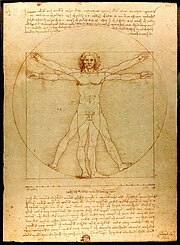Body proportions
From Wikipedia, the free encyclopedia
| This does not cite any references or sources. Please help improve this article by adding citations to reliable sources (ideally, using inline citations). Unsourced material may be challenged and removed. (November 2007) |
While there is significant variation in anatomical proportions between people, there are many references to body proportions that are intended to be canonical, either in art, measurement, or medicine.
In measurement, body proportions are often used to relate two or more measurements based on the body. A cubit, for instance, is supposed to be six palms. While convenient, these ratios may not reflect the physiognomic variation of the individuals using them.
Similarly, in art, body proportions are the study of relation of human body, or in general, animal body, parts to each other and the whole. These ratios are used in veristic depictions of the figure, and also become part of an aesthetic canon within a culture.
Some common proportional relationships for human in European art are:
[edit] Body
- The average adult human figure is about 7 to 7.5 heads tall.
- The idealized human figure is traditionally represented as being 8 heads tall:
- head
- from the bottom of the head to the middle height of a chest (place where a man's nipples should be)
- from previous position to the navel
- from previous position to (upper edge of) the pubis
- from previous position to the middle height of thigh
- from previous position to the middle height of a calf
- from previous position to the point just below the ankles
- from previous position to the feet
- The pubis, or its upper edge, is at mid-height of the average adult figure.
- The length of the shin is equal to the length of the hip for an average adult figure.
- When the body stands upright, the length of the arm is such that the finger tips come down to mid-thigh.
- The arms' wingspan (measured from the tips of the middle fingers) is about equal to the body height.
- The length of the foot is about equal to the length of the forearm.
[edit] Head
- The eyes are at the mid-height of the head.
- The head also can be divided into thirds - from the top of the head to the bottom of the forehead, from the bottom of the forehead to the bottom of the nose, and then from there to the bottom of the chin.
- The width of the head is between four and five eyes wide.
- The nose is the length of the first two notches (joints) of the index finger(from tip) when measured against the very beginning of the nose bridge to the end of the nose.
- The height of the face is about equal to the length of the hand.
- The eyes are separated by a distance of one eye width.
- The bottom of the nose to the corner of the eye is equal to the height of the ear.
- The width of the base of the nose is equal to the width of the eye.
- The width of the mouth is equal to the distance between pupils, or the width of two eyes.
These ratios may not always reflect the actual shape of the model's body, if there is a model. In other cultures, different ratios may be emphasized for different aesthetic effect.
In ancient Greek sculpture, the male figure is traditionally shown seven "heads" tall, with the torso (clavicles to iliac crest), thigh (iliac crest to knee) and shin (knee to sole) each accounting for the height of two "heads", albeit the "head" is considered as including the height of neck. This produces proportions that show the head smaller and the legs longer than reality.
[edit] See also
- The Kanon of Polykleitos
- Vitruvian Man
- Andrew Loomis
- Body shape
- Female body shape


